ECOMMERCE IN 2021:
TOP PLATFORMS REPORT & PREDICTION AND INDUSTRY TRENDS

Background and Methodology
To start with, 2020 has proved the significance of eCommerce since the outbreak of coronavirus has ubiquitously affected consumers’ daily routines and buying behavior. Statistics reveal that the total worldwide eCommerce sales soared a further 118 percent compared to 2019’s as they reached 4.1 trillion USD. This great number has been partly contributed by the nationwide lockdown as a myriad of customers chose cyber-based stores to minimize social exposure. Evidently, 86% of e-merchants claim that their online revenues increased, compared with the pre-pandemic period, ranging from 1 to more than 200 percent!
Since eCommerce is thriving, it is necessary for any virtual business to choose a proper eCommerce platform that meets several criteria, including the website’s purpose, merchants’ demand, technical knowledge, sort of product and so on.
Understanding that struggle, we will be providing you with a research that:
- Recaps what happened in the eCommerce industry in 2020;
- Reveal shopping cart migration upward trends in 2020;
- Reviews prevalent eCommerce platforms in 2020;
- Indicates prevailing eCommerce trends in 2021;
- Predicts top eCommerce platforms in 2021.
With the provided information below, merchants will gain fundamental knowledge to evaluate whether their present platform and its updates can adapt to the current situation and the future of eCommerce.
There are several ways in which we gathered data for this piece of research:
- LitExtension’s in-house data: As the leading shopping cart migration solution, we are exposed to the most notable shopping cart migration trends throughout the year. Our migration data include Source and Target Cart, number of entities each migration, time, date and region of specific migration projects.
- Other references: We gather statistics for this eCommerce report from the world’s most trusted sources, such as BuiltWith, Ahrefs, Google Trends, and Capterra.
However, as the field “Country” is not a required field when filling in information with LitExtension, some of the regional data is missing from our database. For those cases, we instead used the location collected from the country code top-level domain (ccTLD) or the default language or currency of the sites. Doing this does not ensure maximum accuracy regarding the location of the merchants as they may be overseas sellers, but on the other hand, it reflects the choices for particular markets. Additionally, the number of missing data is not large enough to lead to a huge different or imprecise eCommerce industry trends prediction, hence the unbiased results.
Our findings may also differ from global huge brands’ reports as our in-house data does not represent the whole eCommerce industry. However, our target market is not limited to particular areas and our customers come from a variety of regions, so the results can be applied worldwide.
Table of contents
 2020 Recaps
2020 Recaps
 2020 Recaps
2020 Recaps I. 2020 RECAPS
1. WHAT HAPPENED IN 2020?

Here comes a 2020 flashback with all of the significant eCommerce and shopping cart news that influences the current eCommerce industry
eCommerce News
Events | |
April |
|
May |
|
June |
|
July |
|
September |
|
October |
|
November |
|
December |
|
The eCommerce market in 2020 has changed incessantly with much more customers choosing online shopping. As a result, big companies such as Amazon or Walmart achieved great sales in eCommerce despite the effect of COVID-19.
The growth of eCommerce in 2020 has brought merchants great opportunity but also new challenges. Store owners will need more assistance from eCommerce solutions in order to attract more shoppers. Check out the table below to grab the picture of what happened with some of the biggest eCommerce platforms in 2020.
Shopping Cart News
Events | |
January |
|
April |
|
May |
|
June |
|
July |
|
October |
|
September |
|
November |
|
2. ECOMMERCE PLATFORMS’ POPULARITY

In this part, we will be providing you with the popularity of some outstanding eCommerce platforms in 2020 by compiling figures from Ahrefs, BuiltWith, and the like.
When it comes to the universal distribution of eCommerce platforms, we decide to take three criteria into consideration: live websites, market share, and global search volume (as of December 2020).
First, let’s have a look at the number of live websites of each eCommerce platform.
According to BuiltWith:
- WooCommerce has the greatest number of live websites: 2,789,626
- The runner-up is Shopify – one of the most prominent hosted carts: 1,409,539
- Wix ranks the third in this list with notable eCommerce features: 1,339,730
Correspondingly, WooCommerce, Shopify and Wix are the giants with 28%, 14% and 14% of market share respectively.
The graph above compares the global keyword volume of top prominent eCommerce platforms 2020 (Source: Ahrefs). In this aspect, Wix, Shopify and Squarespace may impress you with 7.2M, 4.7M and 1.5M searches correspondingly.
In addition to providing eCommerce features, Wix and Squarespace are initially website builders with outstanding attributes that help users create their own websites. This explains why these two platforms attract such interest.
This world map above illustrates the regional distribution of eCommerce platforms according to the number of live websites collected from BuiltWith.
We can see clearly that European online merchants prefer to build their stores on open-source platforms, namely, OpenCart, PrestaShop, WooCommerce,… Meanwhile, eStore owners in America and Oceania tend to choose hosted solutions such as Shopify, Wix, Squarespace and Weebly for their business. In Asia, WooCommerce and Wix are the two outstanding names reported to be predominant.
Analysing all the data mentioned above, we can conclude that in 2020:
- WooCommerce, Shopify, and Wix currently have the highest number of live websites. Similarly, these platforms accounted for the largest eCommerce market share.
- Wix, Shopify and Squarespace gained the most search volume globally.
- Open-source solutions tended to be more favorable in Europe while hosted solutions were well-received in the America and Oceania market.
In the next part, we will be providing you a comprehensive analysis on shopping cart migration trends in 2020 based on our in-house data.
3. SHOPPING CART MIGRATION TRENDS

In this part, we will:
- Critically dissect our in-house data
- Showcase the most chosen Target Carts (shopping carts that merchants choose to migrate to), and the most Source Carts (platforms were migrated from).
- Analyze several popular eCommerce platforms.
- Determine whether open-source carts or hosted carts are more preferable.
Most Migrated-to Platforms
The below pie charts represent the proportion of Target Cart options in 2020. As an overall trend, Shopify, WooCommerce and Magento were the three platforms that merchants migrated to the most, while only a minority of store owners chose other carts.
As the chart suggests, Shopify accounted for the biggest share among target carts with more than one-third of migration targeting this platform, followed up by WooCommerce with 31,14%. Likewise, Magento also proved itself as a promising platform as more than 20% of users moved their stores to Magento.
Shopify, WooCommerce, and Magento have always been the most popular platforms as the majority of users would choose 1 out of the 3 carts to ship their online store to. In the next paragraphs, we would like to dive into our data and provide you with in-depth knowledge about this year’s fluctuations in the migration trends of these top three platforms.
This chart illustrates the top 3 most migrated-to platforms in 2020. The rankings of the top migrated to platforms changed significantly in the first 6 months compared to the latter 6 months.
- WooCommerce in the first 6 months can be considered as the most popular destination for merchants with 34.7%, outperforming Shopify’s 31.9% and Magento’s 20.7% respectively.
- However, since July 2020, WooCommerce’s number has fallen below 30% while Shopify’s has risen to the top spot with nearly 40% of migrations targeting new stores there. In the meantime, the number of migrated-to Magento stores experienced a mild drop of only 0.5%.
It can be said that the competition between these two eCommerce platforms was so fierce in 2020. There are a variety of explanations for this fluctuation and we are going to clear it up in the next paragraphs.
WooCommerce
During 2020, WooCommerce released 10 new versions from 4.0 to 4.9 with major refurbishments mainly concentrated on 4.0 update. This version gained great user’s acceptance thanks to a bunch of innovative features. First of all, the integrationwith WooCommerce Admin as a streamlined dashboard allows store owners to perform multiple tasks smoothly. Secondly, the newly updated report system and the improved store management tools made the store managing tasks more simple, convenient and time-saving.
When examining the decreased portion of migration to WooCommerce, it is worth mentioning that our total migration projects rose by more than 150% in the last 6 months of 2020 in comparison with the first period. Therefore, despite the fact that the volume of online sellers transferring their stores to WooCommerce grew from 13,85% to 17,30%, the portion of migration to WooCommerce still went down notably.
Shopify
At the beginning of the year, Shopify was the runner up after WooCommerce. However, this shopping cart climbed to the first position at the end of the year due to a number of factors.
First of all, Shopify is the most popular destination for Wix’s users in 2020. The number of Wix to Shopify migration projects took up 12.68% of the total migration to Shopify in the first 6 months. Particularly, this figure in the second half-year surged to 26,79%, which is twice as much as that of the first phase. Low loading speed, lack of eCommerce specific integration, limited number of payment gateways of Wix compared to Shopify might be the culprit of this migration tendency.
Besides, the Volusion Bankruptcy event in late July played an essential role in the overtaking of Shopify. In the first half of the year, the number of migrations measured from Volusion to Shopify accounted for only 2% of the total migration rate to Shopify. However, in the last 6 months this rate climbed up to 4% as a consequence of the above-mentioned event.
Another point that should be highlighted is that last October, Shopify partnered with Tiktok. This partnership helps Shopify merchants create and run campaigns through the social media platforms, which may call for more online sellers heading to Shopify. Besides, in early November, Shopify offered post-purchase upsells directly in Shopify Checkout. Merchants can now seamlessly sell subscription products and offer the best shopping experience for their customers. As a result, online merchants might have shifted to Shopify to take advantage of its features.
Magento
Our statistics show that 20,4% of our customers switched to Magento, helping the platform stand firm as one of the most favourable carts in 2020, just behind Shopify and WooCommerce.
And there was one significant event that greatly affected the Magento migration trends in 2020, which is the Magento 1 EOL (end of life). As Magento announced the discontinuation of support version 1 in June 2020, there have been 64,4% of users moved to Magento version 2. It is reported that Magento 2 platform runs 25% faster and smoother than Magento 1.
Additionally, with improvements to the default functionalities, extended features and the availability of over 350 new extensions, Magento 2 obviously is a spotlight among other platforms.
OsCommerce, an open-source platform that is currently home for over 50,000 stores, has the most users moving from their stores to Magento. According to our in-house statistics, osCommerce occupied 7,10% of total migration heading to Magento. Even though OsCommerce is very friendly for users, it also has fewer features than those of Magento. Also, OsCommerce’s scalability, SEO features are both significantly inferior when compared to those of Magento.
Most Migrated-from Platforms
Below is the pie chart demonstrates the proportion of the platforms that merchants move away the most in 2020.
It is clear that Magento is represented by the largest portion of 27.6%, followed by Wix and WooCommerce, as they accounted for 10,4% and 9,7% correspondingly.
This chart illustrates the platforms that merchants left the most in 2020.
- In the first six months of the year, Magento accounted for nearly one-third of the migration projects, with 30.6%. This percentage was three times larger than WooCommerce, and even six times greater than Wix with only 5.2%.
- In the last two quarters of 2020, there was a steady decline in the number of re-platform projects for both Magento and WooCommerce. Magento still ranked first in this period, making up 28.7% of the total proportion. On the other hand, Wix experienced a notable increase in the number of moving projects, rising from 5.2% to 12.1%. Wix outranked WooCommerce in the latter part of the year, ended up being the second eCommerce platform that users tend to migrate from.
In the next part of this section, we will dive deep into the three platforms mentioned above and figure out the reasons behind this podium. Please note that this result does not serve as an indication of which platform is better, or which is worse.
Magento
Magento stood the highest in the top migrated-from platform. However, bear in mind that the biggest contributing factor to this is the large number of upgrading projects from Magento 1 to Magento 2.
In summer 2020, Magento discontinued their support for the first version of this open-source platform, leading to nearly 50% of our projects moving to Magento 2. Moreover, Magento 1 has been receiving lots of complaints about the usage difficulties, lack of built-in features, and expensiveness. These are some factors that affected users’ migration intent to Magento 2.
“Configuring the platform is frustrating, it needs high skills and is very poor in basic features. You need to install many extra modules and this could make you lose speed and stability.”
Magento users on Capterra
Beside the upgrading from Magento 1 to Megento 2, Shopify is another popular destination for Magento users with 28.7% migrations moving to this hosted platform. Shopify has been proving itself to be a fierce competitor of Magento, thanks to the ease of use, a variety of templates, and its support for any size of business.
Wix
The tendency to migrate from Wix to another eCommerce platform doubled in the last six months of 2020, increased by 6.9% compared to the first two quarters.
The reason behind this trend might lie in the limited feature of this platform. This Israel-based company is more favoured by entry-level online stores as it offers well-designed templates to start your store. However, Wix hasn’t been successful in providing users with a variety of plugins or large storage. Hence, as a business scales up, merchants are more likely to migrate to another more robust platform. This leads to a massive quantity of Wix’s replatforming projects in 2020. According to Store Leads, the number of Wix Store has dropped tremendously in the last two quarters of this year, decreasing by 80% equals 6,420 stores remaining by the end of 2020.
“For a halfway professional web presence, Wix just doesn’t cut it. It’s lack of depth means it’s missing many key features for analytics, SEO and ecommerce and it’s just not able to scale or handle larger sites or multilingual ones. WordPress can do world’s more and is nearly as easy to set up.”
WooCommerce
The number of projects moving from WooCommerce accounted for 10% of the total migration in 2020. Similar to Magento, WooCommerce appeared in both most migrated-to and migrated-from list. The reason behind this phenomenon is that 20% of these projects are to upgrade from WooCommerce to a newer version of itself. Early this year, this WordPress plugin dropped an update for the WooCommerce 4.0 version. However, with this upgrade, users are more prone to conflicts and issues. As a result, several merchants might have their site updated by LitExtension experts to minimize the risks of errors.
Another factor that drove merchants to leave WooCommerce was the platform’s heavy reliance on extensions. WooCommerce has the ability to scale up, however, scaling up means they have to spend a lot on plugins and maintenance. The more plugins installed, the more time and money spent. This could be frustrating and wasting at some points, as a result, hundreds of online merchants sought for another solution to switch to.
“WooCommerce extensions are surprisingly expensive and also subscription-based, requiring an annual fee. Inexpensive third-party alternatives exist, but there is risk involved. – Building an extended “platform” such as a membership site / offering subscriptions (for example) can require multiple paid WooCommerce add-ons that rack up hundreds of dollars in annual fees. – WooCommerce mobile app tools do exist, but do not offer much functionality beyond sales reports. – Highly customized WordPress stores using a lot of plugins are at an increased risk to see major conflicts and performance degradation, and troubleshooting can be difficult.”
WooCommerce users on Capterra
Globally and Regionally
The competition between eCommerce businesses is getting much more severe due to the effect of the COVID-19. Especially when using an eCommerce solution, merchants expect to get the best tools in order to level up their website. Therefore, eCommerce platforms are competing fiercely to expand its popularity around the world.
In this part, we will:
- Analyze the popularity of well-known shopping carts in each continent to find out the top eCommerce platform in 2020 globally and regionally.
- Dig deeper into the migration distribution all around the world and in three biggest continents including Europe, America and Asia.
Let’s have a walk through an in-depth analysis of top common choices of Shopping Carts that online store owners prefer on 3 continents: America, Europe and Asia.
America
The chart below describes the proportion of merchants who decided to migrate their stores to another eCommerce platform in America. We’ve picked three countries with the most migrations: the United States, Canada, and Brazil.
The U.S is one of the largest eCommerce markets in the world. Therefore, it’s no surprise that America had the biggest amount of migration projects according to our statistics. In 2020, Shopify held the first position with 53.95% merchants migrating to, followed by WooCommerce (23.07%), Magento (12.81%) and BigCommerce (5.44%).
Canadian and Brazilian users also prefered Shopify the most (53.95% and 51.72%), followed by WooCommerce (23.15% and 38.89%) and Magento (12.81% and 11.11%). Besides, OpenCart was also a common choice for these two continents accounting for 4.43% and 5.56% respectively.
To conclude, the top 3 eCommerce platforms in America are: Shopify, WooCommerce and Magento. Additionally, BigCommerce and OpenCart are also in the top 5 favorite shopping carts to migrate to in 2020.
Asia
According to eMarketer, The Asia-Pacific region is the fastest growing eCommerce region in the world. We sorted out 5 countries with the most migration projects including India, Australia, HongKong, Singapore and Japan to show you the overall picture of which solutions Asian merchants prefer.
First on the list we have India. The 2nd most populous country in the world tends to chose Magento (44.66%) over any other shopping carts, followed by Shopify (31.55%) and WooCommerce (13.42%).
In Australia and Japan, merchants liked Shopify the most (50.35% and 43.75% respectively) followed by WooCommerce (27.30% and 25%), Magento (10.99% and 18.75%) and BigCommerce (4.61% and 6.25% respectively).
In Singapore, 42.86% merchants picked Shopify, then came OpenCart with 28.57% and Magento with 11.43%. In HongKong, 65.22% of all merchants chose Shopify, 17.39% chose Magento and 8.7% went with WooCommerce.
Overall, Shopify was the most common choice for Asia merchants to migrate to, then came WooCommerce and Magento. OpenCart and BigCommerce also attracted the attention of a certain number of merchants.
Europe
Europe is one of the most important markets for online retailers all over the world. Ecommerce in Europe is expected to be worth 717 billion euros at the end of 2020 – an increase of 12.7% compared to the situation last year.
We will be analyzing 5 countries with the most migration projects: UK, Germany, Italy, Spanish and France. The chart below shows the distribution of the Target Cart choices in Europe in 2020.
In the UK and France, users preffered Shopify (38,2% and 38.53%) to WooCommerce (26.4% and 28.44%) and then Magento (19.1% and 14.68% respectively). Besides, Prestashop (in France) and OpenCart (Both the UK and France) were also considered as good choices.
Unlike merchants from America and Asia, most store owners of Spanish and Germany went for WooCommerce (31.87% and 32.6%) instead of Shopify (24.3% and 28.73%) and Magento (20.56% and 28.18%). In Italy, most merchants chose Magento (32.88%) and WooCommerce (32.88%), then Shopify (12.33%).
Prestashop and OpenCart were quite famous in Spanish. The former was also widely used in Italy.
The top 5 shopping carts that merchants in Europe were into were: WooCommerce, Shopify, Magento, Prestashop and OpenCart.
In conclusion, merchants’ picks in 3 continents are quite familiar. Shopify is the most common choice, followed by WooCommerce and Magento. When combined, BigCommerce and OpenCart are in the top 5 favorites in Asia and America, while Prestashop and OpenCart are in the list of Europe.
That Prestashop is more popular in Europe is understandable, since this open-source platform was born in France and serves French as their official language beside English. Likewise, BigCommerce is from Texas, America, hence the reputation.
However, the need to migrate to a new eCommerce platform of merchants in each continent is quite different. Asian’s and America’s store owners prefer Shopify over other shopping carts while in Europe, merchants are most likely to pick WooCommerce as their new Target Cart.
Open-source vs Hosted Shopping Carts
The following section will answer two questions:
- Do open-source platforms users tend to stay or switch to hosted solutions and vice versa?
- Which type of platform has the most migration-to projects in 2020?
Since the selection between open-source and hosted platforms has always brought the most confusion for online store owners, we believe that the following analysis might be another piece of insight that could come in handy for you.
In 2020, most merchants opted for open-source platforms when performing a shopping cart migration. Of all migrations, up to 64.69% of migrations went to open-source platforms, when hosted carts only took up 34,11% and 1,2% went to other sections.
- Do open-source platforms users tend to switch to hosted solutions?
The chart below shows the migration proportions from open-source carts (to open-source carts and to hosted carts).
It can be seen that the open-source-to-open-source pair has dominated the whole year migration trend with 67,64% of total migration from self-hosted platforms, twice as much as that of hosted which accounted for only 32,37%.
From the given data, it’s likely that open-source users preferred to move to the same kind of platform when they needed to look for another website builder. This is because once store owners can avail of endless customization possibilities of self-host platforms, they might feel uncomfortable with shifting to a hosted solution.
- Do hosted platform users tend to switch to Open-source solutions?
The chart below shows the migration proportions from hosted carts (to hosted carts and to open-source carts).
Throughout the year, a large proportion (60,2%) of sellers using hosted carts chose to move to resembling platforms while the rest switched to open-source platforms. It’s noticeable that the hosted-to-hosted pair’s portion experienced an increase to 65,53% in the second period of the year, which made it almost double the other pair’s figure with merely 34,47%.
In general, the whole year trend presented that the majority of hosted carts vendors tend to switch to other hosted platforms instead of changing to open-source ones. This is an understandable decision, especially for non-tech savvy users as open-source solutions are rather difficult to use and they have to manage everything on their own.
Synthesizing all afore-mentioned analysis, it can be concluded that although users were more likely to redirect their stores to platforms with the same features, open-source carts were still prioritized during the year.
Shopping Cart Migration Trends:
Key Takeaways
Key Takeaways
In this part, based on our in-house data, we have suggested some eCommerce platforms that users prefer to move to, and which platforms should improve themselves to keep their customers onboard. Furthermore, we have analyzed the popularity of shopping carts country-wise and region-wise. Here are our conclusions:
-
Top 3 migrated-to platforms: WooCommerce, Shopify, Magento
-
Top 3 migrated-from platforms: Wix, Magento, WooCommerce
-
Global popularity: Shopify, WooCommerce, Magento, Prestashop, OpenCart, BigCommerce
-
Preferred cart type: Open-source platform
4. TOP ECOMMERCE PLATFORMS IN 2020

After compiling figures from trusted sources of information as well as our in-house data, we would like to make a list of the 6 most popular eCommerce platforms that are worth being heeded in 2020.
Shopify
Since its establishment in 2006, Shopify has become one of the biggest hosted platforms in the eCommerce software market. Currently, Shopify has been home for 1,409,539 online stores. In 2020, Shopify’s global keyword search volumes mainly focused on the UK, France and Canada. This platform accounted for 14% of the total market share.
There are several reasons that stand behind this position: Dedicated Support, Ease of Use, and Ease of Scalability.
- Shopfy satisfies any merchant with 24/7 customer service including email, phone, live chat and tickets..
- While open-source platforms require a lot of steps to set up, Shopify takes the hassles out of creating a website to get the store up and running in a matter of minutes.
- Thanks to the fast site loading speed and fully-functioned inventory management, Shopify is the optimal choice for small to giant businesses or those needing rapid scalability.
To get more professional knowledge about Shopify, please check out this article!
WooCommerce
Launched in 2011, WooCommerce is an open-source plugin that turns WordPress sites into a fully functioning eCommerce store. As of January 2021, there are 2,789,626 live websites operating on WooCommerce. The global keyword research for WooCommerce is estimated to be more than 497,000 searches. Also, this platform is considered as one of the most popular Target Carts according to our in-house data.
WooCommerce is not only user-friendly and easy to customize, but it also offers low-cost payments.
- WooCommerce is targeted at beginners and eCommerce newbies, so WooCommerce developers always try to make it as beginner-friendly as possible for their users.
- WooCommerce stores can be customized in terms of product type, store management, marketing, payments, shipping, enhancement and subscription and so on.
- Finally, WooCommerce is totally free to use and can be downloaded effortlessly from the website. Thus, small and low-budget businesses can consider using this platform to build online stores. Besides, this platform’s customizability also allows large businesses to optimize the potential of online stores at low cost.
Check out this WooCommerce review for more information!
Magento
Though it is not the platform with the highest keyword volume or the most live websites, Magento is still an ultimate choice for medium-to-large companies. It has been home for many famous companies including Ford Motor Company, Christian Louboutin, and Sigma Beauty. Magento was searched for 259,000 times, and it’s currently hosting over 205,000 websites across the globe. In 2020, the number of migration to Magento remained steady, with 20.20% in the last two quarters, just a tad behind WooCommerce in the first position.
There are several reasons behind the popularity of Magento:
- Built to serve medium-to-enterprise merchants, Magento offers a wide variety of advanced and powerful built-in features for your store. Besides, this eCommerce platform also provides the largest selection of extensions (5800+ add-ons) to further boost your online business.
- It provides a high level of security with new security patches released each version. Magento mainly aims at large business, therefore, security is their top priority. They dedicate a Security Center to prevent customers’ websites from external malware and other security risks.
Learn more about Magento features in this comprehensive review!
Wix
Wix is an Israel-based website builder founded in 2006. With the launch of Wix Commerce, Wix lists itself among our top eCommerce platforms of 2020. Wix’s keyword search volume is 7.2 millions, ranking it first as the most searched website builder. The number of live websites also showed that this platform attracted a host of new users in 2020. However, this platform is in the list of the most Source Carts in 2020, meaning that though gaining the excellent first impression, Wix tends to be losing customers later on.
There are several reasons behind the popularity of Wix:
- One strong point of Wix is that it’s truly easy to use. With its drag-and-drop mechanism, and the newly introduced tool, Wix can be an excellent choice even for those with little knowledge of coding and design. Wix provides clear and meticulous instructions to guide users through each step.
- This website builder offers over 100 templates free-of-charge specially made for eCommerce stores which could be a savior for beginners. Also, with the newly introduced – Wix Editor X, users can create a webstore with a stunning design while being fully responsive.
Prestashop
The open-source eCommerce platform has achieved significant growth in 2020. In general, Prestashop is quite famous in Europe, especially in France. With the latest version Prestashop 1.7.7.0 released in early October 2020, Prestashop currently has 313,032 live websites equivalent to 6% in the eCommerce usages distribution on the entire internet. Moreover, the open-source shopping cart is also in the top 6 favorite choices of merchants all around the world to migrate-to.
There are several reasons behind the popularity of Prestashop:
- As an open-source eCommerce platform, Prestashop is a great option for merchants who not only want to take advantage of the flexibility of the open-source nature but also appreciate the ease of use when it comes to store management, SEO, inventory and so on.
- This open-source offers a massive amount of add-ons along with 4,000+ professional ecommerce website templates so merchants can make a stunning store with just some simple steps.
Let’s find out more about Prestashop here!
Squarespace
The last one on our list is Squarespace. As of January 2021, the platform hosts more than 790.000 live websites and accounts for 8% of all eCommerce usage on the entire Internet. According to our in-house data, Squarespace is also in the top 7 eCommerce platforms that merchants like to migrate to.
There are several reasons behind the popularity of Squarespace:
- Squarespace is a hosted eCommerce platform with all the basic features needed for an online store. Besides, it provides powerful and super easy to use website builder tools.
- The customization is also a plus for Squarespace. The eCommerce solution offers you a developer mode to tweak the structure of your templates or build your theme from scratch to make your store appearance just the way you want. Moreover, the SaaS solution also provides you with a set of best-in-class commerce templates to showcase your products at their absolute best.
- If blogging is one of your central website elements, Squarespace is your solution. You can trust it to showcase your content as it offers all the necessary blogging features as well as the advanced ones (eg, geolocation tags, AMP support).
Check out this article to see if Squarespace is your ideal host for the website!
In the next part, we will be providing you with our predictions about eCommerce in 2021.
Keep reading on!
II. 2021 PREDICTIONS
1. WHAT IS SHAPING THE FUTURE?
6 ECOMMERCE TRENDS

In this part, we will:
- Indicate how people are changing their shopping behaviors
- Predict eCommerce trends in 2021
As stated in part I, the statistics and analysis show that eCommerce changed incredibly during 2020 based on the note-worthy events in eCommerce. For most consumers, the period of Covid-19 made a substantial impact on their shopping habits.
The purpose of this part is to indicate how people are changing their shopping behaviors in order to predict eCommerce trends in 2021. Although the effects of Covid-19 brought out the challenge of distinguishing the reactions to Covid from what the trends in eCommerce really are, we – LitExtension experts are attempting not to let the pandemic affect the final outcome.
To give you a better picture of what’s happening in this industry, we have collected some of the most notable eCommerce trends that somewhat describe the future of online shopping.
Buy Now, Pay Later (BNPL)
In the plight of lockdown and the Covid-19 trauma, changing the way customers purchase products takes center stage in the conversion generating process. And, it looks like “Buy now, pay later” eCommerce is here to say. For beginners, “Buy now, pay later” is a payment technology that allows a buyer to make a purchase without having to pay for it immediately. It is an alternative to credit and gives purchasers flexibility to shop what they want. Most importantly, when consumers split the cost of the purchase and follow the payment schedule, they will not have to pay any interest or fee.
In 2020, while coronavirus is driving more consumers to buy online, this condition may have hastened the use of “buy now pay later”. Some big eCommerce players like Amazon are jumping to the BNPL trend by working in close partnership with Citi credit card. Furthermore, Paypal introduced “Pay in 4” this year to allow consumers to split purchases into 4 interest-free installments, once every 2 weeks. Or Klarna – a new app that supports “buy now pay later” service – has doubled the number of its US customers to 11 million, including 2 million active users who used to be the debit cards holders. We can confidently assert that this eCommerce trend in online shopping will substantially grow in the near future.
According to a survey by personal finance site Ascent, over a third of US consumers have used a BNPL service. Most people use these plans to avoid paying credit card interest or buying something not in their budget. Another survey carried out in October 2020 by Cardify – a data firm tracking consumer spending, shows that nearly half of the consumers said they spend from 10% to over 40% when they use the “buy now pay later” plan compared to when they use a credit card.
A recent report from IBISWorld predicts the BNPL industry will continue to increase 9.1% in 2020-2021, bringing it to $741.5 million. As a result, the world leading BNPL services such as Afterpay, Klarna and ZipPay become increasingly popular to the checkout processes of online retailers.
Free Shipping
Free Shipping is another factor significantly affecting the online purchasing decisions. According to the B2C site report, orders with free shipping average around 30% higher in value and 93% of online shoppers are encouraged to buy more products if free shipping options are available.
Unless sellers provide very expensive products, offering sitewide free shipping on all orders will likely not be a feasible option for them. In case the merchants worry about being in charge of the shipping fee, there are still several ways to implement free shipping on their online store while still being profitable:
- Increase the product price: If the products are priced moderately, baking the cost of shipping into the product price is an effective strategy.
- Increase average order value (AOV): Merchants can minimize losses by offering bundles or a minimum spend threshold.
Additionally, there are plenty of shipping solutions for eCommerce sellers that dedicate their entire staff to helping you figure out how to ship faster and more affordably. Each of these solutions helps with a variety of things, but most offer:
- Shipping label printing on-demand;
- Multi-warehouse pick, pack and ship rules;
- Packaging and label customization and branding.
Here are some names of the top eCommerce shipping solutions ShipperHQ, Shipstation, Aftership, etc.
Sustainability
Recently, online shoppers have always been concerned that whether their purchased products are enviromentally friendly or social responsibility oriented. In 2020, we witnessed large companies making moves to increase their focus on green consumerism such as Nissan, Whole Foods, Starbucks and far more. Research from Cone Communications CSR (Corporate Social Responsibility) Study shows that 87% of people would buy a product with a social and environmental benefit if given the opportunity and 88% would be more loyal to a company that supports social or environmental issues.
With the impressive statistics shown above, we can assure that sustainability will competitively drive sales.
The renewed focus on environmental sustainability is a clear sign that online merchants must step up by observing eco-friendly practices. If merchants haven’t had any social or environmental responsibilities within the products or services, a perfect way to start is changing the packaging.
To conclude, consumers around the world are demanding sustainable packaging. Businesses that respond effectively with sustainability campaigns can expand and enhance their image.
Artificial Intelligence (AI)
The concept of Artificial Intelligence, or AI, has been around for a long time. However, AI has been an innovation in eCommerce and developing as well as creating a profound effect on our daily life only in the last few years.
AI undoubtedly plays an integral role in scaling up online businesses, which motivates more and more organizations to corporate AI as a way to improve workflows and automate processes. By 2022, online sellers are predicted to spend $7.3 billion on AI, as customers become more accepting of personalized shopping and data-driven recommendations.
The Chinese company Alibaba is the world’s largest eCommerce platform that sells more than Amazon and eBay combined. To optimise this marketplace, AI is included in Alibaba’s daily operations to predict what customers might want to buy. With the use of natural language processing, the company automatically generates product descriptions for the site.
According to FinancesOnline statistics, 69% of consumers said they’d prefer chatbots for receiving instantaneous responses. Chatbot with new AI integration will help the chatting experience become more personalized, branded and more intelligent. With the help of the AI in eCommerce, personalized product suggestions for online shoppers are increasing conversion rates by 915% and average order values by 3%
AI also provides eCommerce merchants with a scalable solution which works around the clock, using natural language processing (NLP) to help people find what they’re searching for or even make complaints. By 2021, more than 80% of customer interaction on the Internet will all be handled by AI (Gartner research).
In the digital era, merchants must be able to contextualise, optimise and narrow down search results for their customers. AI enables the store owners to leverage cookie data and provide shoppers with highly tailored offerings.
AI is powerful beyond imagination. And it comes with huge possibilities and opportunities. A quick and more personalized customer service, retaining customers, devising effective marketing strategy – AI single-handedly looks after everything. eCommerce stands to benefit tremendously from AI, and this tool is forecasted to be worth $27 billion in retail alone by 2025.
Social Media
Social media is not what it used to be. It’s no longer a channel by which people connect with others. Social media has evolved to a marketing tool, enabling brands to further reach their target audiences. Currently, there are over 3.4 billion users across Facebook and Instagram which is a fertile land for merchants to set up their business. It’s fair to say social commerce can be one of the hottest trends in social media today, and it seems to have an even bigger impact in 2021.
On social media platforms, customers will be able to discover brands through social contents, and find products they normally wouldn’t search for on an eCommerce platform. Over 81% of UK customers surveyed admitted to purchasing a product after seeing it on social media. Moreover, the social element also makes it easier for brands to create interactive, sharable campaigns that help new products go viral.
Also, the great news is that in Oct 2020, Tiktok has made a partnership with Shopify which can bring the Chinese-owned app in line with social media rivals such as Facebook. Through the new partnership, Shopify merchants will be able to connect to a Tiktok for Business account and add a Tiktok tracker to their store. The purchase is made on the Shopify store, so transaction and customer data stay with the retailer rather than Tiktok.
Platforms like Instagram and Facebook have been equipped with “buy buttons,” which allow retailers to sell through them. Online stores have also been establishing links with social media platforms, enabling customers to make purchases. As a result, in Mid 2019, Facebook launched Instagram Checkout saying that its goal was to build a better experience for users to shop directly on Instagram. Furthermore, in the US, customers are more accustomed to purchasing directly from the brand rather than on marketplaces such as Amazon, which accounts for 49% of eCommerce and even more for smaller-value items such as basic apparel, consumer electronics, etc.
To better connect with target customers, the merchants should consider investing in an omnichannel social media sales strategy. Customers would like to keep in touch with a company through various channels such as: online website, email, Facebook Messenger, Instagram direct message, social media, and more. For a fully omnichannel experience, social platforms need to be seamlessly integrated. Everything happens on social media nowadays, which means that business owners should acknowledge the power this tool has for their customers.
Visual Commerce using AR tools
Augmented Reality (AR) is no longer a new term for the tech-savvy people as it was first introduced in 1990. Later on, AR has been used in the eCommerce industry since 2016 which indicated a positive sign of the new online shopping experience. In the situation of Covid-19, AR is rapidly on the rise and becoming an eCommerce trend. Not to mention the pandemic, AR itself is a powerful tool that the merchants should invest in to greatly enhance the shopping experience.
With the rise of AR tools, retailers can even project how the product would fit virtually on the customers. Aside from visual showcases, this trend also includes functionalities that enhance the way customers discover the offerings via search.
Here are some of the impressive statistics which shows the future of visual commerce and AR tools:
- Image influence: 83% of shoppers will click to product images as they are the most influential factor in their purchasing decisions.
- Increased shopper engagement and trust: visual images using AR tools can boost customer engagement by 66% over the traditional images.
According to Gorniak – CEO of Threekit, he admits that companies have a once-in-a-generation opportunity to embrace the new way people are going to be buying. Even after the pandemic is over, people’s expectations for better visual experiences will be higher, so it’s imperative for companies to make sure they are meeting these demands.
2. TOP ECOMMERCE PLATFORMS IN 2021

2020 has been a tough year for both merchants and customers. Let’s head to 2021 with our compelling list of the top 5 eCommerce platforms which are predicted to make your online business flourish.
Shopify
It’s no surprise that Shopify is still in the top eCommerce platform list in 2021. Trusted by millions of merchants, Shopify is the best solution when it comes to building online businesses.
Shopify is proud to satisfy the demands of many merchants by providing up-to-date tools for eCommerce trends. First of all, Shopify and Shopify Plus have taken businesses to a new level with Omnichannel. Omnichannel has been integrated with Shopify since the end of 2019. Shopify has also partnered with Facebook since May 2020 to help small-to-mid-sized businesses create branded storefronts and unique in-app shopping experiences on the new Facebook Shops and Instagram Shops.
Running an omnichannel business is serious work. The more channels you extend your store on, the more important it is to have a watertight inventory system that puts everything in the right place. Understanding merchants’ concerns, Shopify offers lots of tools that can help solve optimization challenges to increase profit and protect the inventory system. Since then, more and more businesses have been taking the advantages of the omnichannel sale to sell their products.
We predict the number of merchants leveraging omnichannel selling will dramatically increase in 2021 and the following years. An IDC report found that retailers using omnichannel commerce solutions saw a 15-25% increase in average order values, 5-10% increases in customer profitability, and 30% higher customer lifetime value.
It can be seen that Shopify, with its constant updates in the current eCommerce situation, is definitely one of the best eCommerce platforms ever.
Magento
Magento has long been a solution for medium-to-large businesses. Favored by an array of well-known brands, Magento has always been among the top eCommerce platforms for many years and we believe that Magento will be on the list in 2021 once again.
Magento can seamlessly enable a perfect omnichannel strategy. This platform provides a “Magento Order Management” feature that provides a seamless customer experience, increases sales while reducing costs, and accelerates the time to market.
Also, this platform is well-equipped with a bunch of Augmented Reality (AR) extensions in the marketplace, therefore merchants can effectively customize their stores to follow the eCommerce trends. In April 2020, Product Recommendations is built and powered by Adobe Sensei – artificial intelligence (AI) and machine learning technology – to help merchants create engagement, increase conversion and drive revenue. The merchants can now deploy automated product recommendations across their storefronts to help their customers discover relevant products throughout the shopping journey.
Since its acquisition by Adobe, Magento has geared up its pace for releasing regular updates for all editions. With its announcement about the release of Magento 2.4 in Q1 2020, the number of new active stores dramatically increased to more than 22,000. With Magento’s impressive growth and continuous updates, this platform will definitely be the wise choice for online merchants to build up their business.
Although using Magento brings the challenge of a steep learning curve, it is still one of the most powerful eCommerce platforms in the market. Surely, this platform can help merchants grow their businesses without a hindrance.
WooCommerce
WooCommerce is considered as an ace WordPress plugin. Based on data from StoreLeads, the number of new WooCommerce users is currently more than 400,000 in 2020 only. We predict that this number will steadily grow more in 2021.
Merchants favour this platform because it has a high level of customization thanks to the open-source nature. As a WordPress plugin, WooCommerce is also one of the most stable and advanced CMS for SEO and blogging. In addition, one of WooCommerce’s strong points is that it offers tons of plugins/ extensions that can support merchants’ expansion and growth. Users can access plugins on both WordPress and WooCommerce marketplaces.
Following the eCommerce trends in 2021, sellers can avail of payment gateways like Stripe, Paypal, AmazonPay or even options for ”buy now pay later” (BNPL) like Afterpay, Klarna. AR tools such as CartMagician will help merchants bring their online store to life by offering customers a virtual try-before-you-buy experience in their own environment. For approaching wider customers, WooCommerce also integrates with the most powerful and potential social media platforms such as Facebook, Amazon,.. to help merchants sell through multiple channels. The base plugins are 100% free, and there are plenty of modestly-priced extensions that can extend your options even further.
This revolution will enhance the shopping experience which can be very helpful for merchants to increase sales and conversion rate.
Wix
Wix is a name that most people are familiar with as both a website builder and an eCommerce platform. With the substantial increase in the number of users in the first half of 2020, Wix is undoubtedly a strong competitor among the top eCommerce platforms in 2021.
The reason why Wix is expanding rapidly is that more and more store owners are choosing an easy-to-use platform. Wix’s strongest point is that this platform is an all-in-one, drag & drop, cloud-based web development tool for merchants to start running their businesses without having to know a line of code.
To follow the movement of the eCommerce industry, Wix has connected with Facebook and Instagram Ads and lifted up the omnichannel selling by allowing users to manage any purchase from a single dashboard. All you need to do is set up your Ads on your store dashboard and the Wix AI will take care of the rest for you.
Plus, Wix has finally integrated with several of BNPL solutions for small-to-medium businesses to give customers financial freedom. Using Wix, businesses can offer pay later options to their customers with no additional integration costs.
With all the outstanding features listed above, Wix has been attracting more and more merchants. We hope that 2021 will be a blooming year for Wix and its millions of users!
Prestashop
PrestaShop has always been considered as one of the optimal solutions and favoured by most of European merchants.
With more than 600 features and over 5000 modules & themes available in the marketplace, PrestaShop provides virtually everything required including BNPL service, omnichannel or AR tools. Because PrestaShop is an open-source platform, users and developers are guaranteed a secure, scalable, flexible and sustainable solution for all eCommerce projects.
However, PrestaShop doesn’t seem to provide many updates and new features during 2020 to respond to the global situation. Therefore, if PrestaShop doesn’t make a huge breakthrough in 2021, it will be hard for them to stay in the top-list eCommerce platforms in the following years.
Other Prominent Shopping Carts
Apart from all the giants, there are also a few competitors that are on their way to being in the top list. Here are 5 platforms that we believe will make drastic changes to the eCommerce industry in the near future:
- OpenCart is an easy-to-use, powerful, open-source platform that can manage multiple online stores from a single dashboard. This platform is a bright competitor because the increase of live websites in Q4 2020 is three times higher than Q3 2020. It can be easily seen that the OpenCart 1.5.xx update released in September 2020 is the main reason merchants switch to OpenCart. We believe OpenCart and its updated features will be even more successful in 2021.
- BigCommerce is an optimal eCommerce solution for medium to large businesses. This platform also integrates with Amazon, eBay and it has social selling and omnichannel capabilities. Being offered dominant features, it is perfect for merchants to clinch the deal easily. Furthermore, BigCommerce also has a ShipperHQ integration, which offers customers good deals of free shipping. With tons of powerful features provided, BigCommerce can quickly follow the eCommerce trends without a hitch and become one of the top eCommerce platforms in the industry.
- Squarespace has been selected in the top 6 eCommerce platforms in 2020. This platform is gradually strengthening its position as it continues to appear in the top eCommerce platforms in 2021. With the steady growth in live websites compared to 2019, we expect the number of users to continuously increase in 2021. We hope that Squarespace in 2021 will be able to flourish above expectations to meet all users’ demands.
- BigCartel is an eCommerce platform for artists and creators who need a place to sell artworks, clothes, jewelries, and photo prints. With an outstanding increase in users in the third and fourth quarter of 2020 (StoreLeads), BigCartel is predicted to be a potential competitor in the top list.
- Ecwid is a cost-effective solution for small and medium-sized enterprises to sell their products widely. With more than 10,000 new stores built this year, Ecwid is bound to be more successful in 2021.
Final Words
All in all, the year 2020 has passed with opportunities as well as challenges for online businesses. E-merchants have to adapt to the changing shopping behaviors and therefore, they have to look for the most suitable eCommerce solution for their business. Correspondingly, the competition among eCommerce shopping carts has become more and more intense, with new versions and updates.
Having analysed in-house as well as other data about eCommerce platforms and its migration trends, this paper can be summarized as follows:
- Open-source was the most migration-to type of eCommerce platform.
- The top 6 eCommerce platforms in 2020 are: WooCommerce, Shopify, Magento, Wix, Prestashop, Squarespace.
- The top 5 projected eCommerce platforms in 2021 are: WooCommerce, Shopify, Magento, Wix, Prestashop.
If you are an online seller and you are looking for the perfect platform for your business in 2021, take a look at this:
- If you are an eCommerce newbie without any technical base, Shopify or Wix would be a wise choice thanks to the ease of use. Besides that, WooCommerce is another decent option for those with a tech base and wish for full customizability of the e-store.
- As your online business grows with an increasing number of new customers and orders, migrating to a more robust platform is a wise decision. While Wix and Squarespace are more likely to meet beginners’ satisfaction, Shopify is a powerful platform that allows online merchants to scale up their businesses. Apart from that, Magento and WooCommerce are suitable for experienced merchants who need robust tools to leverage their stores.
- Apart from the top 5 eCommerce platforms mentioned above, OpenCart, BigCommerce, Squarespace, Prestashop, and Ecwid are the next best options for merchants. These solutions have experienced a steady rise in popularity throughout the year. With more and more features added, in the near future, we may watch some changes in the top 5 eCommerce platform list.
We will wait and see whatever the future holds for these eCommerce platforms, and we will meet again next year!
Thank you for reading, see you in our next industry report!
We hope you found this paper insightful.
Now we’d like to hear from you about:
- Your current eCommerce platform
- Your opinion about the projected top 5 platforms listed?
- Other eCommerce trends worth mentioned in the paper
Let us know by leaving a comment below right now!
Subscribe to our newsletter to update more eCommerce platforms’ news!
*Your email address will not be published*
 2021 Predictions
2021 Predictions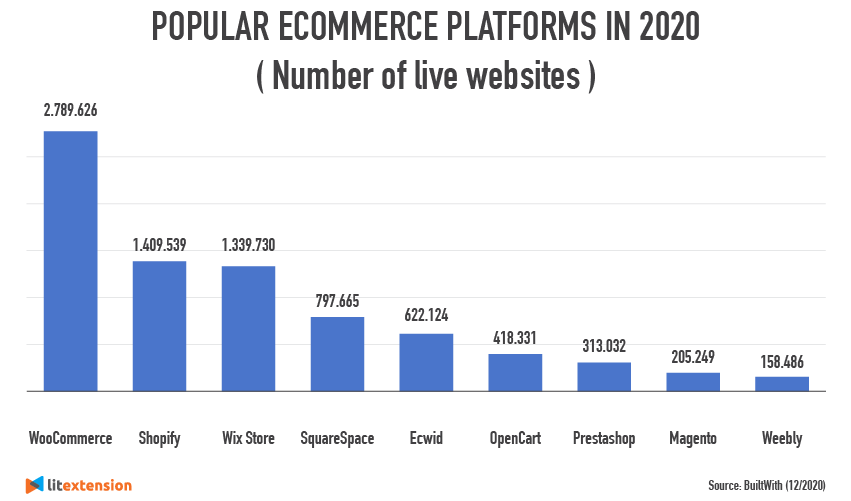
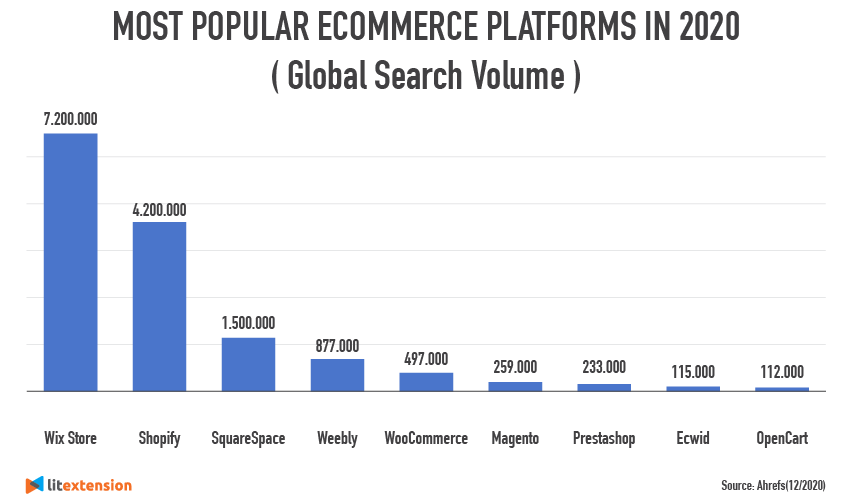
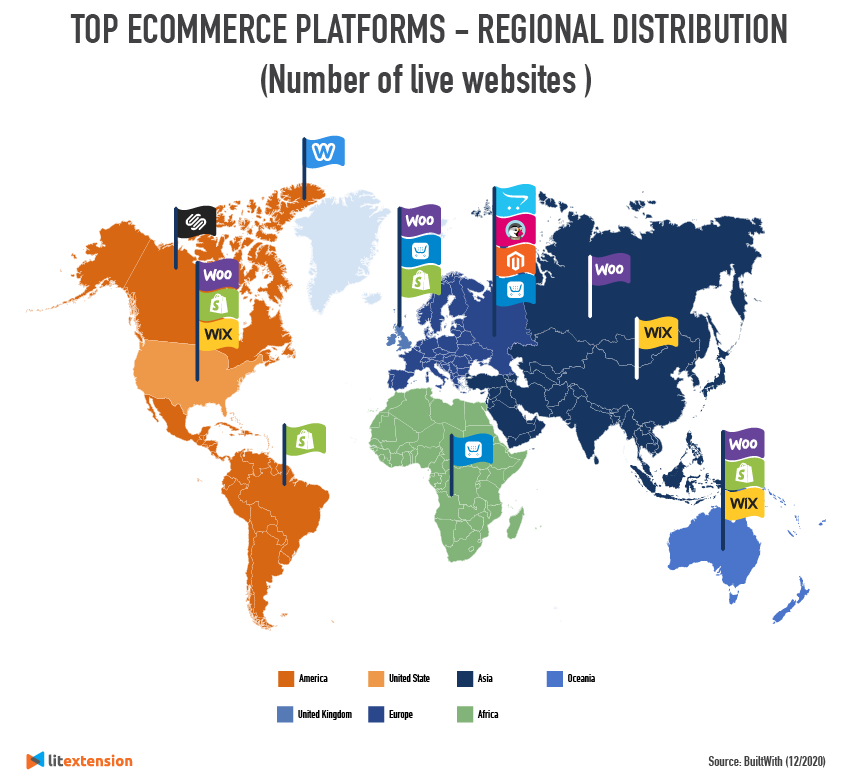
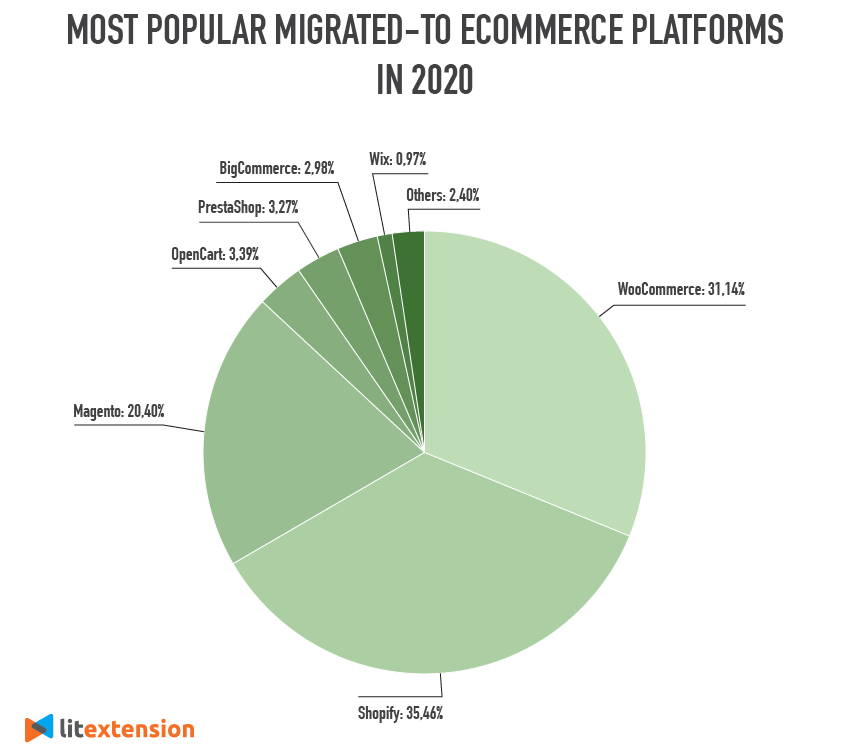
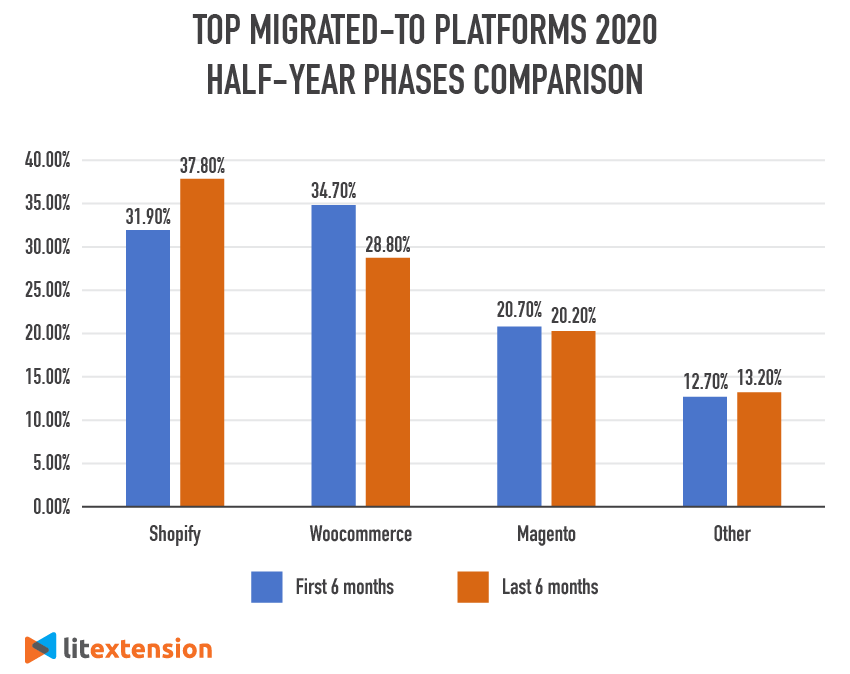

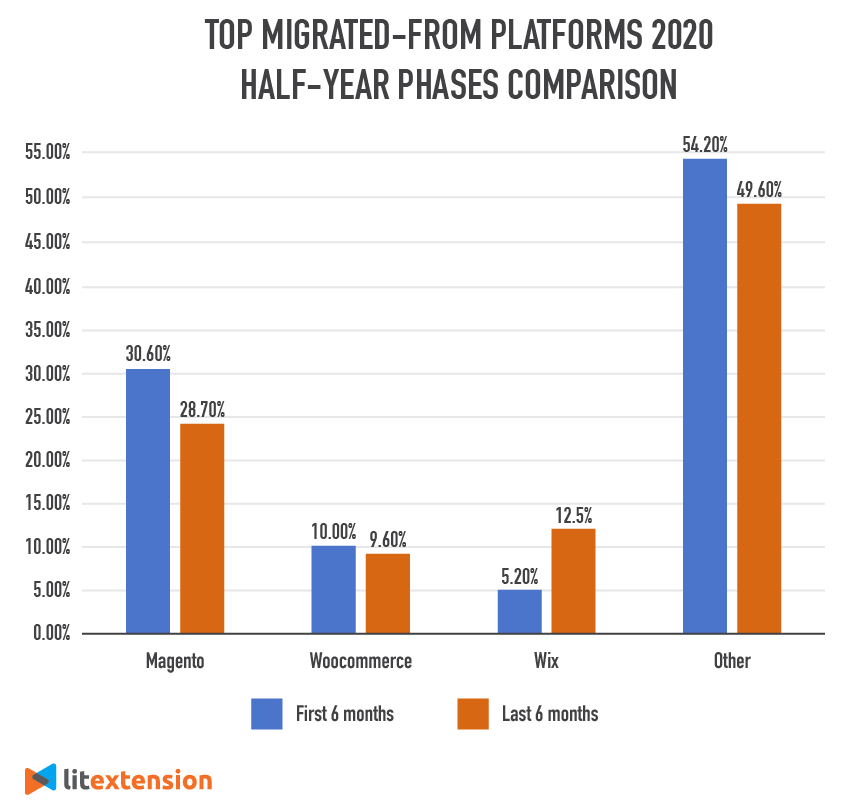
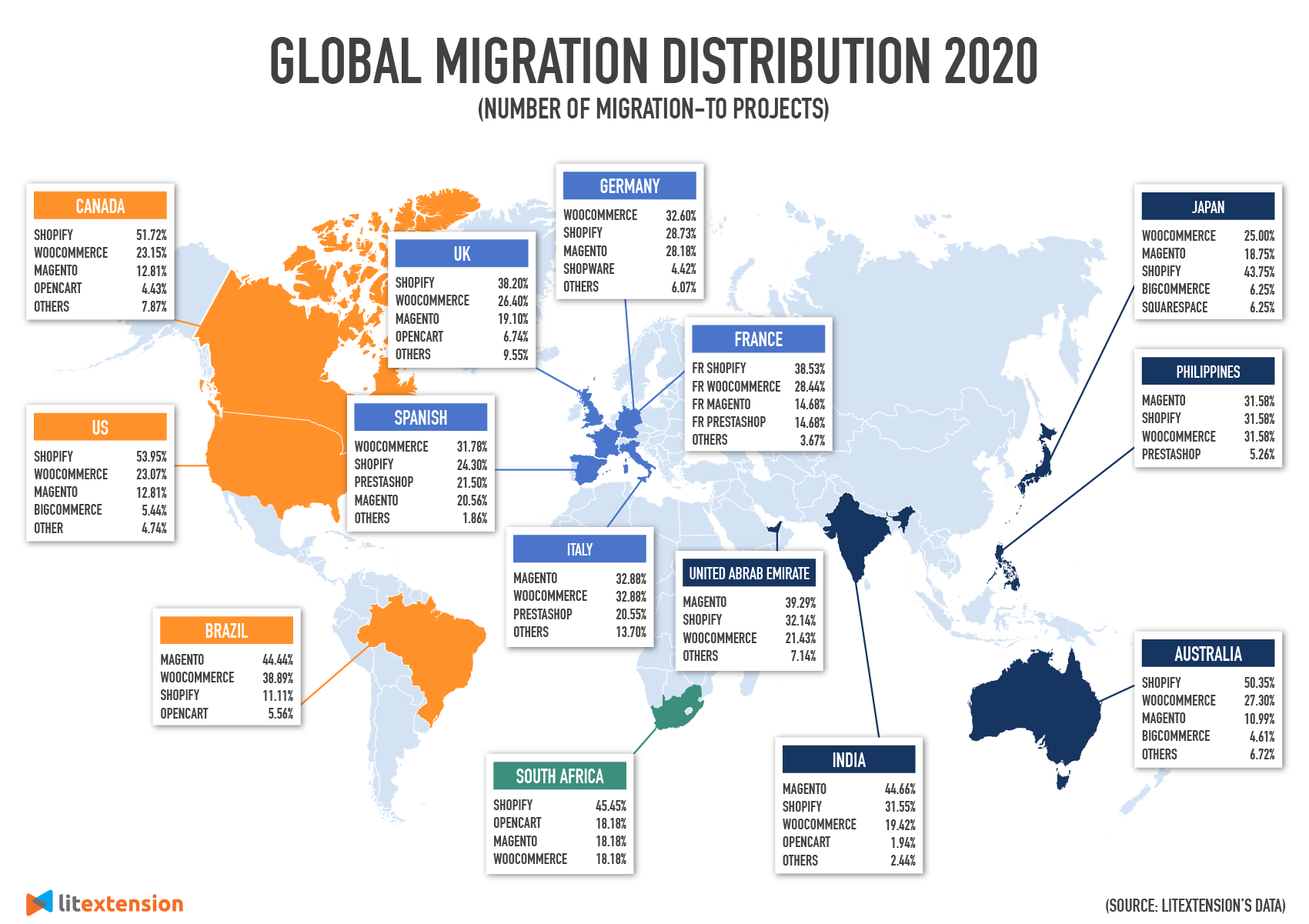
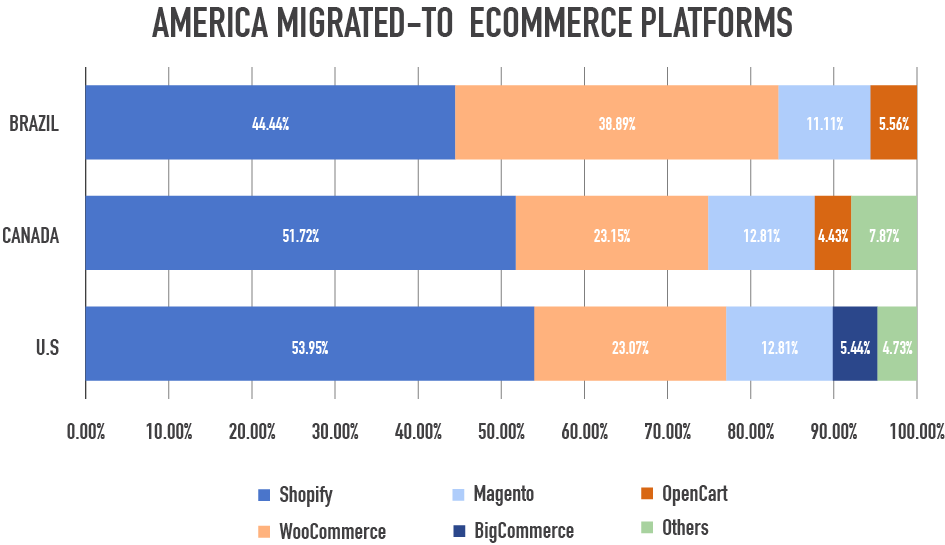

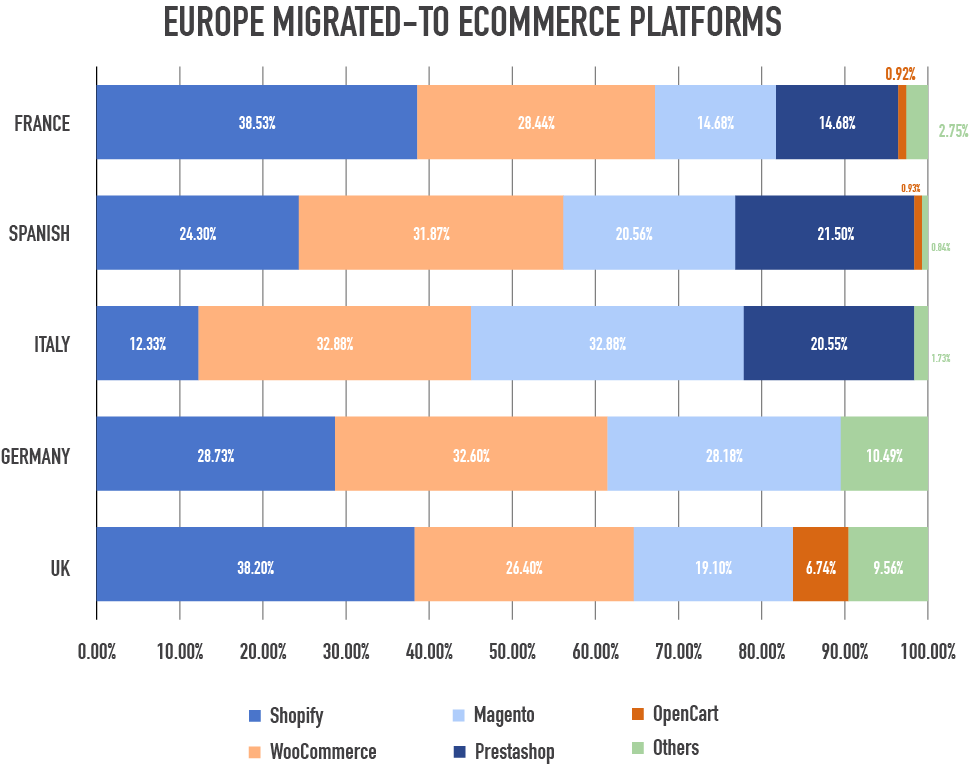
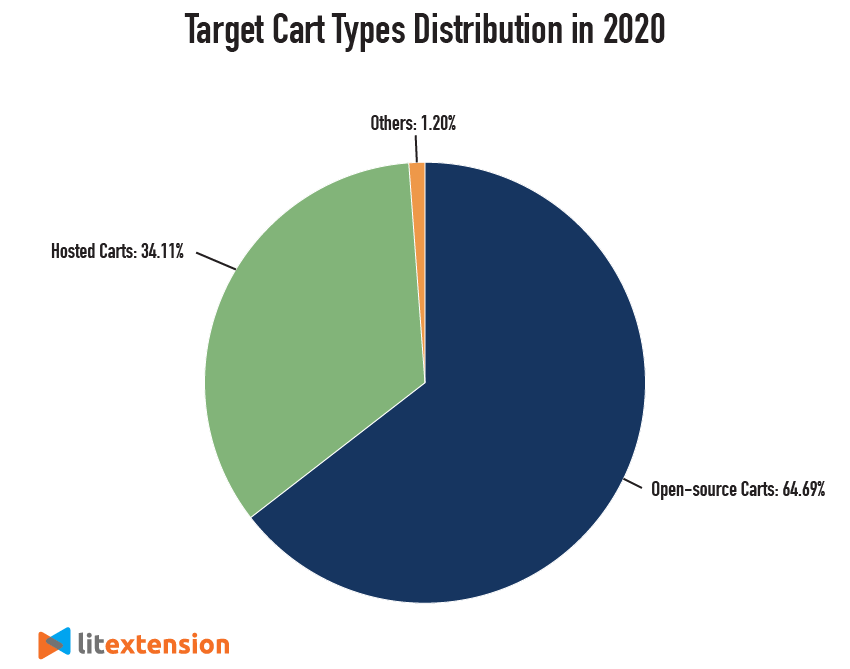
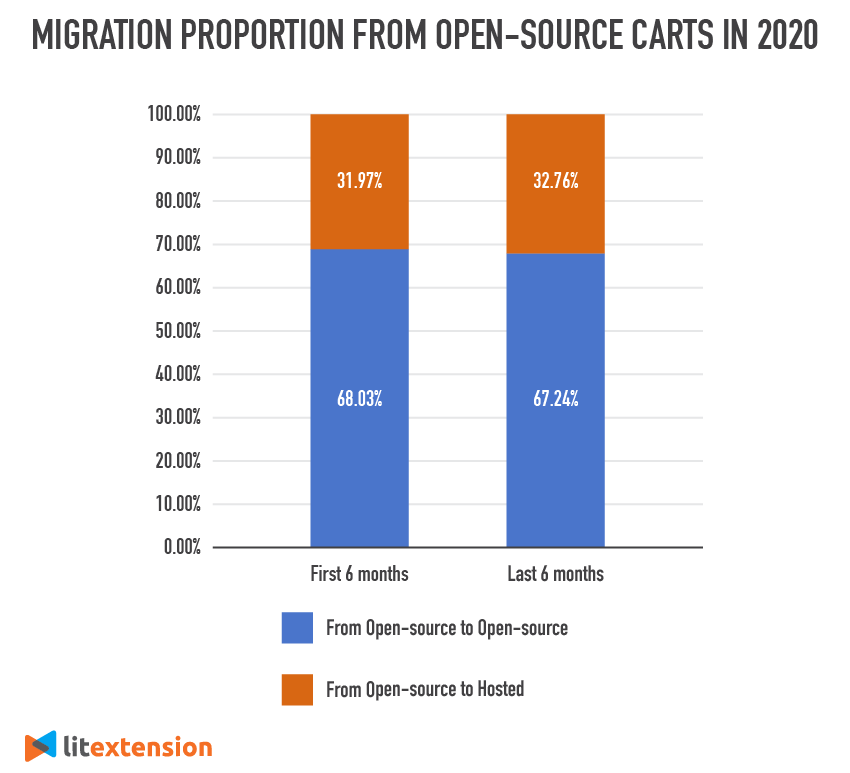

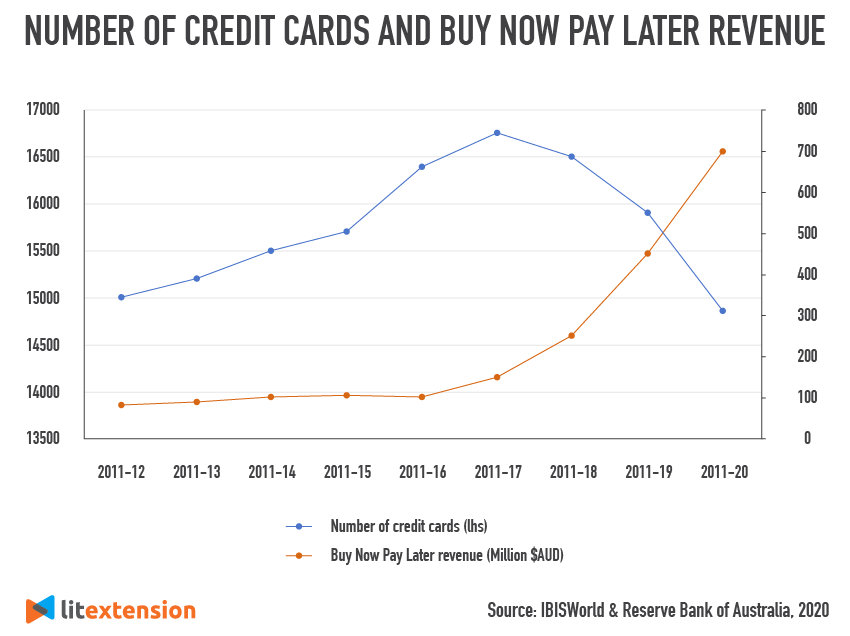






Leave a Reply
You must be logged in to post a comment.